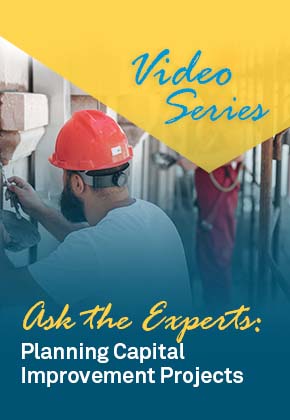Executing a Capital Improvements Plan
Learn about capital improvements - from planning to execution.
Download our guide, Building to Last: Mastering Capital Improvements.
Download our guide, Building to Last: Mastering Capital Improvements.
 In a FirstService Residential survey, more than 83% of associations said they are investing in capital improvements, with 20% focused specifically on adding or enhancing amenities. Since one of the main responsibilities of a board member is to make decisions and policies that help enhance property values, it’s critical that you proactively invest in capital improvements. From replacing essential equipment like boilers, air conditioners, and front gates to adding new features to your property like rooftop cabanas on the pool deck, capital improvements are a necessary part of building your reputation, increasing property value and enriching the resident experience.
In a FirstService Residential survey, more than 83% of associations said they are investing in capital improvements, with 20% focused specifically on adding or enhancing amenities. Since one of the main responsibilities of a board member is to make decisions and policies that help enhance property values, it’s critical that you proactively invest in capital improvements. From replacing essential equipment like boilers, air conditioners, and front gates to adding new features to your property like rooftop cabanas on the pool deck, capital improvements are a necessary part of building your reputation, increasing property value and enriching the resident experience.So how do you successfully plan and execute capital improvement projects in your community or high-rise?
-
First, choose the right capital improvements for your association (and residents).
Before you move forward with a potentially big investment, make sure you are doing it for the right reasons. Ask, why are we considering a capital improvement project? Is the project a necessary replacement? Is the objective to ensure the structural integrity of a building? Is it an investment designed to help us stay current or ahead of the competition? “When talking about capital improvement projects, you typically have two categories of communities: those who are looking to keep costs low while making improvements that will maintain the property and those who are trying to boost their reputation and relevance by strategically investing in the latest amenities and property enhancements,” said Anthony Gragnano, vice president at FirstService Residential. “These are very different motivations that require different approaches.”
Before investing time and money in a capital improvement project, take the time to survey owners and understand their wants, needs and priorities. Even when it comes to replacing essential infrastructure such as elevators and gates, it’s important to gather resident feedback if there’s going to be a significant change to the design or function of the equipment. Examples include going to a self-serve guest access gate system instead of a staffed one, or installing new elevators that will require key or biometric access. Residents feel valued when their input is taken into consideration, and gathering their input now can help mitigate conflicts down the road. Emphasizing how the improvement will enhance residents’ lifestyles will make it more palatable, especially if there’s a big price tag attached.
“Material changes to Florida properties often require a positive vote from 75% of the membership, and that could stand in the way of a board getting work done,” Gragnano said. “Communities should effectively communicate the proposed material changes and what those changes will achieve, then survey the membership to take their feedback into account before launching a significant capital project.”
-
Second, explore project details and requirements with your fellow board members and management company.
If your community is managed by a professional property management company, ask them about similar projects in other communities they manage. A management company with a large portfolio of properties (both local and national) will be able to share a variety of examples at different budget points. Ask for a tour so you can see the finished projects in person and speak with board members to learn how the project went. If possible, ask to see projects at different levels of complexity. For instance, one project may involve new carpeting, another may include carpeting and hallway renovations, and the next may include carpeting, hallway renovations and lobby updates. Compare costs to judge what a little extra investment may get your community.
Make sure you are exploring all the project details and requirements for the project, including pricing, design options and a rough timeline – and the project manager who will get the job done on time and on budget. Getting these details and numbers together will help you advocate for a plan. Once your board lands on the right options, that information must be communicated to residents for their consideration.
Most people do best when they have something to look at before making a choice, so FirstService Residential regional director Kristina Inkrott suggests a standard procedure to get started: "Boards should hire a designer to tour the property, provide ideas, and present them to the membership. This will give them something to consider and vote on."
“We often recommend that communities or buildings host an owners’ informational meeting. We bring in the vendors and engineers and provide an open forum for residents to ask questions,” explained Bobby Knuth, regional director at FirstService Residential. “The goal is to involve owners so they understand the scope of the project and get an idea of what to expect as the project proceeds. Then we summarize what was discussed and share it with everyone who was not able to attend.”
After you’ve solicited resident feedback, presented the membership with options and received buy-in, keep the community updated throughout the project, especially if and when there are delays or complications.
-
Third, determine your funding options.
Before making any plans, make sure you have the funds to complete the project successfully. Begin by reviewing your reserves and other funding options. Your reserve fund should always be the starting point for replacement of essential equipment. Hopefully, your reserve study and assessments have aligned so that you have the money on hand to replace things like HVAC equipment and pool pumps without needing to seek a loan or levy an assessment. If your reserves aren’t sufficient, your property management company and financial provider should help you identify possible funding sources.
“Many communities think they don’t have the funds to even consider a capital improvement project, but there are different funding options that, in the long run, can make real sense for them. They just don’t know about them,” said Gragnano.
Once you’ve landed on the right funding options, it’s time to get to work.
-
Fourth, bring on your project manager.
Once you know what you want to accomplish and how you will pay for it, bring in your project manager. The project manager is key to the success of your project. They are usually a licensed engineer, with expertise in construction projects and the knowledge to inspect contractor work and develop a timeline to keep the project moving on schedule. Don’t look to your property manager to be your project manager. Your property manager isn’t licensed or qualified to do this very specialized type of work. Plus, they must continue running your community, leading your staff, overseeing your budget, paying your bills and making sure that preventive maintenance is done properly.
When your project manager is on board, start soliciting bids and vetting vendors. A quality property management company will have a slate of vendors, reliable and vetted, to help get you started with this process. Because of FirstService Residential’s vast portfolio and presence in Florida – and all of North America – associations are able to see examples of capital improvement projects in comparable communities or high-rises and get valuable tips and best practices on how to select the right vendors. Your professional project manager will also have the skill set and knowledge to help with the vetting process.
With guidance from your association manager, vendors and a project manager for capital improvements, develop a general timeline. If your residents are largely seasonal, consider trying to complete capital improvement projects in the off-season so that residents return to an improved property. Florida’s off-season is during the summer, which is also the rainy season in much of Florida, so build in weather delays accordingly. If your residents are not seasonal, you may be better able to complete needed work in the dry season (winter).
-
Fifth, finalize the project details, including project manager, board, management company and vendor responsibilities.
Many board members are understandably hesitant to take on capital improvement projects on their own. However, with the right management company and project manager on your side, you can look to them to help facilitate the capital improvement project, from concept to communication and everything in between. Danny Ellis, president at FirstService Residential, said “Property managers will work with the board to determine a scope of work, collect bids, present bids to the board and help negotiate contracts. We do whatever makes the job go more smoothly, including making sure that bills are paid on time. We also work closely with your project manager, ensuring that they have the information, tools and support they need to get the job done properly.”
-
Finally, expect the unexpected.
Remember that even if you plan every detail, select the right vendors, communicate thoroughly and fund your capital improvement – the unexpected can happen. For example, installing a new elevator may lead to another necessary change, such as upgrading the fire panel. Updating the floor tiles in an elevator may change its weight, requiring new testing and certification. You may tear out a wall and a city inspector will recommend or require other work be done to bring an area up to code. Cosmetic changes often end up being more than cosmetic changes, and again, a professional engineer is the best person to guide your association through that process.

Watch the full video!
When you live in a community association, capital improvement projects are a fact of life, yet many board members struggle with the complexities they present. Watch our video to learn how to kick off your next capital project.WATCH NOW!